(click on photos to enlarge image)
HISTORY AND ORIGIN OF CLARET JUGS
The name "Claret" has a French origin and means "bright" or
"clear" and refers to a bright French Bordeaux wine.
In the 18th century there flourished a wide production of silver
mounted cruet stand bottles. They were sized from 15-18 cm, but
no taller or larger bottle suitable to serve wine was
manufactured! The first examples of "wine" bottles were made in
the 1830s and among the first were those manufactured in London
by Reilly & Storer.
Although glass was used for drinking vessels since the earliest
times, only the 19th century saw the development of the "Claret
Jug". Silversmiths began "modifying" glass decanters used in the
18th century by the addition of simple bands of silver and
replacing glass stoppers with silver hinged lids.
In the second quarter of the century, silver handles and larger
mounts were added, although, in most cases, the glass maintained
"bottle" shape and restrained design.
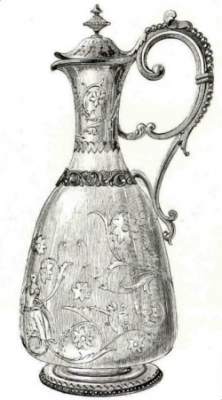 |
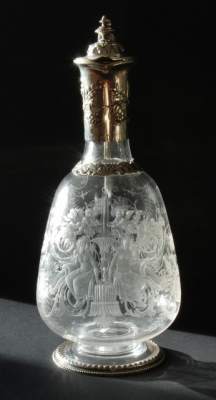 |
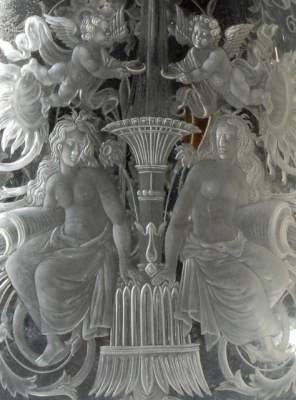 |
Drawing showing Apsley Pellat and
John Figg jug - World exhibition
|
Apsley Pellat and John Figg jug
|
Apsley Pellat and John Figg jug (detail)
|
From the middle of the century, old rules were abandoned and
Claret Jugs became one of the preferred methods for artists to
display their skill on the production of fabulous and often
bizarre designs.
Claret Jugs were produced throughout Europe and, although France
had a large production of fine silver and glass jugs, most of
the diverse and often beautiful designs that we can now treasure
are of British manufacture.
British Claret Jugs have a wonderful glass body and perfect
silver decorated mounting, as do the Russian pieces, especially
those made by Gratchev or Faberge, attaining the highest levels
of quality.
French manufacturers, perhaps as a consequence of the great
tradition existing in wine production in their country,
displayed creations characterized by highly functional shapes
The British silversmiths, less conditioned by the "culture" of
wine, demonstrated broader creativity, stronger innovation and
frivolous attitudes in their manufacture.
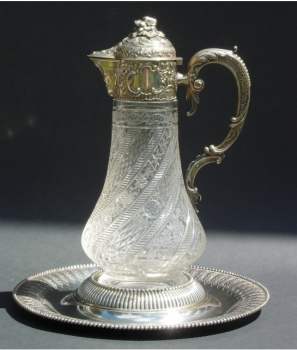 |
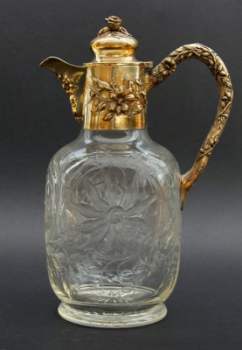 |
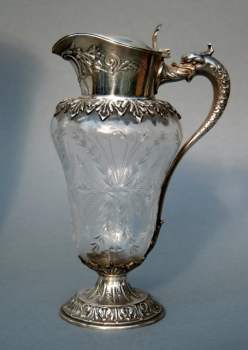 |
Austria Vienna - J.C.Klinkosch 1890
|
Austrian art nouveau claret jug 1900
glass by Lobmeyr
|
Gorham claret jug 1900
|
Since the 1850s, many of the leading British manufacturers
were producing fabulous hand engraved glass bodies. As many of
their factories were located in the north of the country, the
majority of their silver mounts were hallmarked in Birmingham
and Sheffield Assay Offices.
As the European "grand tour" was in great fashion among the
"wealthy minority", the demand for more fanciful models grew and
designers researched their inspiration in the styles found in
Europe; from geometric Grecian patterns to classical scenes in
the "romantic" style of contemporary French painters.
By the third quarter of the century, jugs of the most bizarre
form were in great fashion and in many cases the glass bore
little resemblance to the early "bottles". The mounts were often
chased in perfect symmetry to the glass. Curiously, this was
also the period characterized by some of the most delicate items
and several prominent silversmiths created rare and unusual jugs
in "naturalistic" form. Flowers, such as roses, crocuses and
water lilies, were copied perfectly to silver mounts and glass
decoration which then were assembled to perfection.
From 1875 the forerunners of the Art Nouveau period were
experimenting with the re-discovered Japanese art and the
Aesthetic period became hugely popular. In Germany and Austria
the Art Nouveau period led to the production of Claret Jugs
with wonderfully decorated glass bodies but also, and often, to
plain body artifacts.
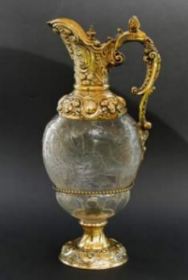 |
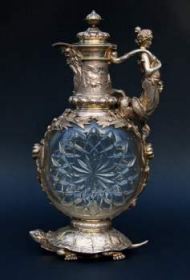 |
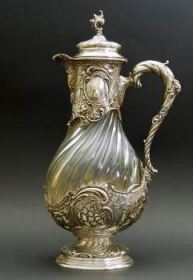 |
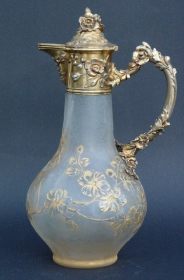 |
Charles Edwards
1898 London
|
The turtle jug
Germany 1890
|
Koch & Bergfeld
1890 Germany
|
Germany 1890 with
French Daum glass body
|
Claret Jugs became for the artist the perfect medium to
reproduce the delicate forms used for centuries in the Far East.
Butterflies and birds, but also plants and flowers, became a
common engraving, often with the addition of other small
subjects in Japanese taste (a delicately engraved fan was often
added amidst birds and foliage).
The 1880s saw the start of the manufacture of the rarest jugs
ever produced, in the form of animals, birds and fishes. These
magnificent creations were made in very limited quantity and by
a restricted number of silversmiths, presumably because they
required the highest craftsmanship level to attend to their
manufacture. The most stunning of these forms had the glass
realistically cut and engraved to simulate the texture of the
model in minute and intricate details (feathers of a duck or the
hair of a monkey). A lot of highly unusual, unconventional and
extravagant examples can be seen in the website
"www.claretjugs.com", a collection formed by Richard Kent.
More common Claret Jugs, but also showing a wide range of
variety, can be seen also in my little collection at
www.karaffensammler.at .
At the end of the 19th century the production of these beautiful
objects ceased for a variety of reasons. The vivacious market of
exotic Victoriana was replaced by the austerity of the Edwardian
period, and this, coupled with the high cost of producing fine
glassware, marked the end of 75 years of fine design and beauty.
From the 1920s no more remarkable Claret Jugs were produced.
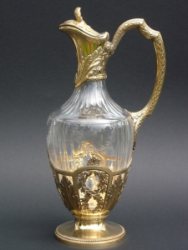 |
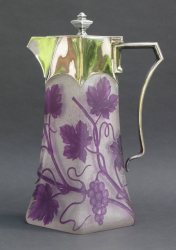 |
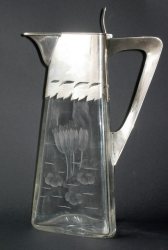 |
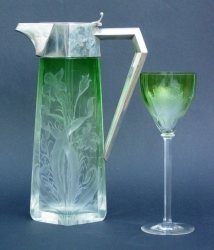 |
French Claret jug by
Risler & Carre 1870
|
Berndorf - Austria 1905
( plated )
|
Alfred Pollak
Vienna 1900
|
Moser Karlsbad claret jug
and its goblet
|
|
|
The author has been collecting silver Claret Jugs for more than
20 years and is the owner of a "Private
Collection of Claret Jugs, Ewers, Crystal Jugs,
Decanters and European Silver".
The collection is widely illustrated in the website at
www.karaffensammler.at , offering an overview of
European silver, particularly Claret Jugs, Ewers and
Decanters made between 1830 and the 1930s.
An excellent web site, worthful of a visit by whoever is
interested to the matter.
You may contact the author at
silber@karaffensammler.at
|
|
 ASSOCIATION OF SMALL COLLECTORS OF ANTIQUE SILVER
ASSOCIATION OF SMALL COLLECTORS OF ANTIQUE SILVER












